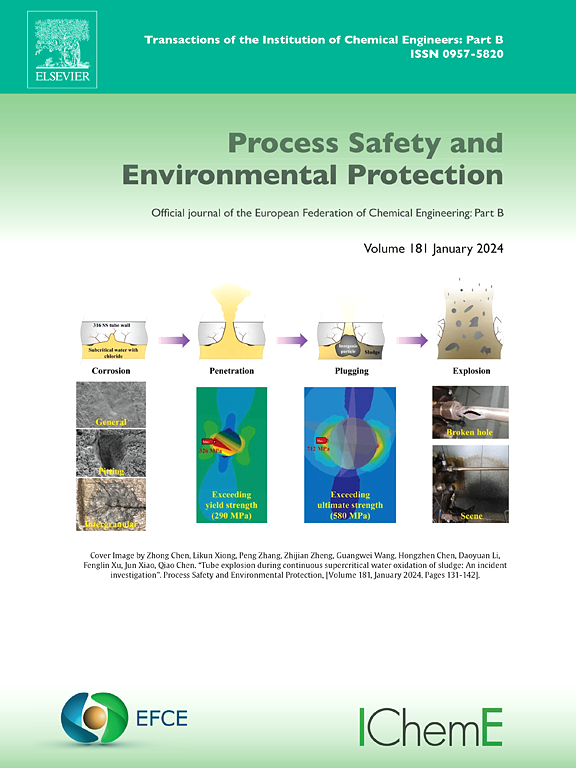了解高铬钒渣镁化焙烧过程中V、Cr的原子演化机制,实现尾矿毒性最小化
IF 6.9
2区 环境科学与生态学
Q1 ENGINEERING, CHEMICAL
引用次数: 0
摘要
高铬V渣(VS-HCC)是提取V的主要原料,VS-HCC中V和Cr的演化机制决定了V提取过程的生态友好性。为了最大限度地降低提钒后尾矿中六价铬和残余钒的含量,本研究引入了 "原子气氛 "方法,在原子尺度上研究镁焙烧过程中 VS-HCC 中钒和铬的演化机理。在 900℃ 煅烧初期,FeV2O4 和 FeCr2O4 尖晶石消失,转化为 Fe2O3-V2O3 和 (Fe0.6Cr0.4)2O3,V 和 Cr 的化学态不变;Fe2TiO4 尖晶石被氧化生成 FeTi2O5。焙烧 10 分钟后,Fe2SiO4 结构完全破坏。尖晶石的转化和 Fe2SiO4 的完全分解都为含 V 相的氧化创造了有利条件。焙烧 50-90 分钟后,V 原子从混合价态(V4 +/V5+)转变为 V5+。这种转变涉及 Mg2+、O2- V5+ 和 Mn2+ 离子的结合,从而形成 Mg2V2O7 和 Mn2V2O7 晶体。同时,Cr 原子仍以无毒 Cr3+ 的形式存在于 (Fe0.6Cr0.4)2O3 中,确保了 VS-HCC 镁焙烧工艺的生态友好性。本文章由计算机程序翻译,如有差异,请以英文原文为准。
Understanding the atomic-scaled evolution mechanism of V and Cr in V slag with high Cr content during magnesiation roasting toward tailing toxicity minimization
V slag with high Cr content (VS-HCC) serves as the primary raw material for extracting V, and the evolution mechanism of V and Cr in VS-HCC decides the eco-friendliness of V extraction process. To minimize the Cr(VI) and residual V(V) content in tailings produced after V extraction, this work introduces the "atomic atmosphere" method to investigate the evolution mechanism of V and Cr in VS-HCC during magnesiation roasting at the atomic scale. In the early stage of roasting at 900℃, the FeV2O4 and FeCr2O4 spinel disappear and are converted into Fe2O3•V2O3 and (Fe0.6Cr0.4)2O3, with the chemical states of V and Cr unchanged; Fe2TiO4 spinels are oxidized to generate FeTi2O5. After roasting for 10 min, Fe2SiO4 structure is completely destroyed. Both the conversion of spinels and the complete decomposition of Fe2SiO4 have created favorable conditions for the oxidation of V-bearing phases. After roasting for 50–90 min, V atoms transitioned from the mixed valence states (V4 +/V5+) to V5+. This transformation involved the combination of Mg2+, O2- V5+and Mn2+ ions, resulting in the formation of Mg2V2O7 and Mn2V2O7 crystals. Meanwhile, Cr atoms still exist as nontoxic Cr3+ in the form of (Fe0.6Cr0.4)2O3, ensuring the eco-friendliness of the magnesiation roasting of VS-HCC.
求助全文
通过发布文献求助,成功后即可免费获取论文全文。
去求助
来源期刊

Process Safety and Environmental Protection
环境科学-工程:化工
CiteScore
11.40
自引率
15.40%
发文量
929
审稿时长
8.0 months
期刊介绍:
The Process Safety and Environmental Protection (PSEP) journal is a leading international publication that focuses on the publication of high-quality, original research papers in the field of engineering, specifically those related to the safety of industrial processes and environmental protection. The journal encourages submissions that present new developments in safety and environmental aspects, particularly those that show how research findings can be applied in process engineering design and practice.
PSEP is particularly interested in research that brings fresh perspectives to established engineering principles, identifies unsolved problems, or suggests directions for future research. The journal also values contributions that push the boundaries of traditional engineering and welcomes multidisciplinary papers.
PSEP's articles are abstracted and indexed by a range of databases and services, which helps to ensure that the journal's research is accessible and recognized in the academic and professional communities. These databases include ANTE, Chemical Abstracts, Chemical Hazards in Industry, Current Contents, Elsevier Engineering Information database, Pascal Francis, Web of Science, Scopus, Engineering Information Database EnCompass LIT (Elsevier), and INSPEC. This wide coverage facilitates the dissemination of the journal's content to a global audience interested in process safety and environmental engineering.
 求助内容:
求助内容: 应助结果提醒方式:
应助结果提醒方式:


